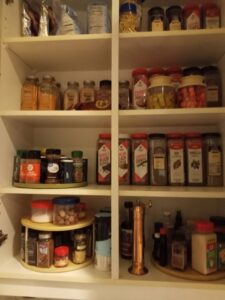Different organizing methods have been touted as ones that can transform our lives: the Marie Kondo regimen that elicits joy, and others that make things easier on our loved ones who inherit our stuff–like Swedish death cleaning–a technique that purges our house of unnecessary things.
What if we instead arranged our house for livability? This type of organizing can be a long process (especially for people who are working and may have limited time). Organizing for livability consists of four distinct steps:
- purge: [get rid of items that we don’t need]
- clean: [wipe down cabinets and inside drawers; then use drawer liners, sink mats and pan protectors to protect the space]
- sort: [put like things with like – this step will most probably entail moving things to different parts of the house]
- organize: [arrange what’s left]
I attacked each drawer/closet/cabinet in my house and garage, sorting and sifting (tossing, mending, cleaning, fixing) and storing the remainder in an orderly manner.
I began small: one room at a time, and within that room, one corner or drawer at one sitting. The process was iterative: instead of a “one and done,” I revisited areas that I had previously organized, a process that resulted in consolidation: moving like things into one central area (like all my makeup into a cosmetic organizer within a bathroom drawer). I parted with the outdated, the questionable and the unknown, cleaning each space before putting things back.

A takeaway is knowing exactly what I have and where it is. Another is finding hidden gems in between book pages, within containers, behind books on a shelf, stuffed deep inside a drawer, and underneath furniture and within crevices.
Organizing the master closet was more daunting, because it entailed trying on everything I own. Clothes that fit, looked great, and could be altered were kept. Some pieces were tossed, and the remainder donated. The type of item determined the destination. Does your community have a clothes closet that helps students who are looking for jobs, or working adults who are seeking to interview? Shoes, purses, and accessories can find a repurposed home. The shoes that I kept were sent to the cobbler for repair, and later polished and then shined. Clothes that I kept were sorted by use/color and hung on matching hangers.
Organizing for livability makes us more likely to enter and to enjoy the space we’ve arranged. The process frees us from wondering “where is X?” In my purge, no corner was off limits–including a toolbox that was difficult to close, most likely because it was stuffed to the brim. In the spirit of consolidation I transferred junk drawer finds to their respective toolbox compartment and purged as I went.
A tiered wooden storage box rescued silver that was tossed together inside a buffet drawer; linens were cleaned and later sorted inside two brand new fabric storage boxes.
Files: I organized files one folder at a time. Two file drawers were sorted into business and personal. Many papers were tossed, and the remaining ones condensed within smaller file folders. Purge, clean, sort, and organize. When I reached the homeostasis of “done” the four-step process became easier as I revisited drawers, containers, rooms, closets, and files. Even CDs and DVDs were sorted by genre, with several donated to a local senior center.
Cars: Our cars may be one of the last organizing frontiers. The glove compartment for example is a space that can get easily out of hand. Essentials include a flashlight and a folder with insurance card, instructions on what to do in case of an accident, our latest vehicle registration, and a record of the latest oil/tire/battery change and transmission check.
Computers. I sorted through jump drives, included documents and folders to keep on a master drive, and copied this to two other external storage devices (each week, rinse and repeat). Cloud storage is a plus. Missing files can be a major source of expenditure and expense–not to mention personal angst as well.
Keeping on top things is a challenge, which is why a master list of house maintenance is helpful. Postponed issues–whether for our person or our property–can create problems. Regular cleaning (e.g., changing the air conditioner filter, dusting and vacuuming) has both health and aesthetic benefits.
Ultimately the four-step process is about discipline-arranging our day by rising on time, by not wasting time, sticking to a budget, not purchasing frivolous items, by attaining our goals and making plans, and by meeting with people who can help us (like money managers) to ensure that we get to the place we want to go. Livability focuses on possibilities–which we can better see when our space is clean, purged, sorted, and organized.
- decluttering is discipline that translates to other areas of our lives
- What else can we eliminate?
- Less is more
- Less helps us to take better care of what we have – and facilitates the process of reorganizing
- Not minimalism–but making things manageable
Related post





Recent Comments